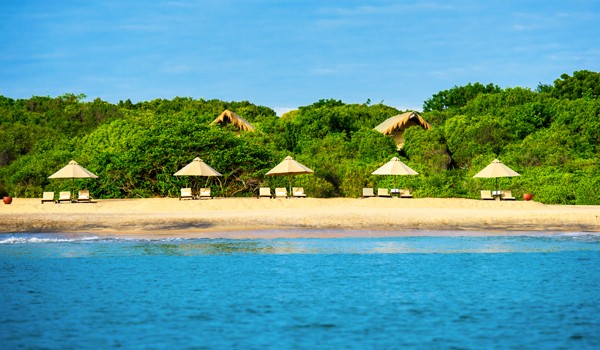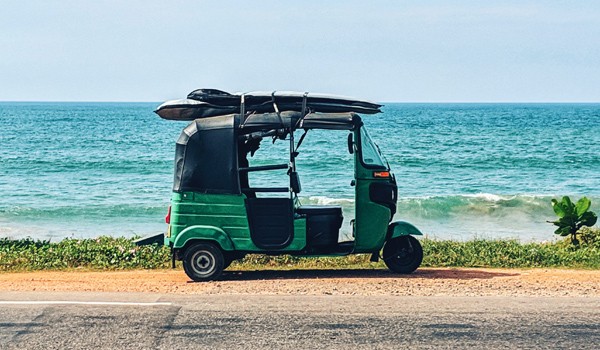The east coast of Sri Lanka is remote and picturesque. With stunning blue ocean fronts and pristine, white, sandy beaches, it is the best place for a quite beach stay. Filled with authenticity, local culture and fresh seafood, this region is for travellers who seek genuine interactions and local experiences.
Dotted with fishing villages, sprawling white, sandy beaches, Hindu temples, hidden bays, colonial forts, a handful of locals with contagious smiles, hidden national parks and sparkling ocean fronts, unmistakably this is Sri Lanka’s east coast. It is a wonder how such a stunning region remains off-the-beaten track, away from crowds of tourists, maintaining its charm and authenticity. The east coast comprises of four main areas stretching along the coastline, each with its own unique character and appeal. Trincomalee, known amongst the locals as Trinco, is on the topmost of the east coast and just over 100km to the northeast of the Cultural Triangle. It has one of the finest natural deep-water harbours and as such, has been popular both for trading and as a military base throughout history. Colourful streets, colonial forts, and small-to-large fishing boats dominate Trincomalee’s landscape.

Amongst these, the iconic Koneswaram Temple stands out while Fort Fedrick reminds travellers of Trincomalee’s colonial heritage. Just outside Trincomalee are the quiet and beautiful beaches surrounding Nilaveli, Uppuveli and Kuchchaveli. Trincomalee has also established a reputation for sightings of marine life. It is one of the best places to view blue whales and sperm whales annually during May to November. Pigeon Island National Park, just 1km off the coast of Trincomalee, is a wonderful place to dive, snorkel and get up close and personal with marine life including reef sharks. Travelling down the east coast from Trincomalee is the sandy, sprawling beaches of Pasikudah and Kalkudah. Situated just over 100km from Trincomalee, these two hideaways offer uninterrupted views of the Indian Ocean and a suntan to last a few months. Although one might say that Pasikudah and Kalkudah are characterless, this stretch has some of the best beaches to soak in the sun. They are very much quieter which is an added benefit.

Batticaloa, fondly known as Bati, on the other hand, is full of local character and unusual charm. Predominantly an agriculture and fishing-based village, this is the second-largest town in the east coast. It is a busy town, populated with colourful houses, churches and a picturesque lagoon. Its Dutch-built Fort still remains intact. The town is surrounded by emerald-green paddy fields and endless prawn harvesting tanks that are unique to the area. While Batticaloa is not a popular destination to stay, it is a great place to stop and immerse in the quiet, peaceful and uninterrupted eastern countryside of Sri Lanka. The last stop on the east coast is Arugam Bay. As the name reflects, it is a bay that is synonymous with breakwaters for world-class surfing. The surrounding area is demographically diverse. This is also home to a handful of Europeans and Australians who settled in this area decades ago.

Arugam Bay has its own quaint character dotted by numerous guest houses and small hotels, and from May to November the place buzzes with mostly surfers from all corners of the world. This influx of travellers has created a street food scene and cuisine that are unique to Arugam Bay. For the remainder of the year, this quaint place stays quiet and uninterrupted. Read more on Arugam Bay here. (link) Kumana National Park is one of the highlights of this region, a lesser-visited, hidden gem that has thus far has been explored only by the keenest of wildlife enthusiasts. It is less than an hour’s drive from Arugam Bay, therefore can be easily visited while staying at the east coast. Kumana National Park is best known for its avifauna and migratory waterfowl and wading birds.

However, sightings of bigger animals including Sri Lankan leopard and sloth bear are frequent. One of the best parts of visiting this national park is that it lacks crowds, making viewing almost always private. The east coast consists of warm and humid climatic conditions throughout the year with an average temperature of 27°C. However daytime temperatures climb to 30°C and over. Sri Lanka’s east coast has a number of accommodation options including high-end boutique hotels to quaint barefoot luxury accommodation with character. This area is best visited during the season from May to November. Include the east coast at the end of the tour for four to five nights is the ideal way of exploring the area.

Here are sample itineraries featuring the East coast of Sri Lanka. Click below to read more about accommodation on the East coast of Sri Lanka or get in touch to receive a detailed, tailor made itinerary for your Sri Lanka holiday.
A holiday for travellers looking for warm weather,...
13 DAYS/12 NIGHTS
I Need A Tropical Holiday
Read MoreDesigned to showcase some of Sri Lanka’s best heri...
11 Days/ 10 Nights
Sri Lankan Escape
Read MoreA private tour of Sri Lanka to experience its very...
19 Days/ 18 nights
Sri Lankan Food Trail
Read MoreA family holiday in Sri Lanka that is both active...
11 days/ 10 nights
Sri Lankan Family Explorer
Read MoreA perfect mid-year holiday for those travellers lo...
13 Days/ 12 Nights
Sri Lankan Mid-Year Escape
Read MoreAmazing trip! We absolutely loved it. Sri Lanka is now a country we would definitely like to go back to and explore further.Thank you so much for all the work you did in putting the trip together for us. It was a great mix of places for us to get a good feel of the country. We will be encouraging all our friends to go to Sri Lanka.